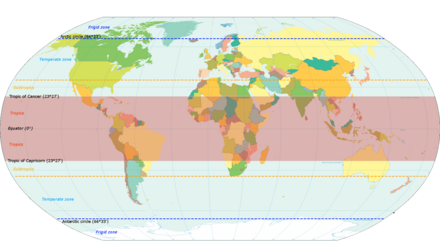Tropical rainforests have climates that receive high temperatures and high humidity throughout the year. While they are closely tied to the geographical boundaries of the tropics, not all the land in the tropics is covered by tropical rainforests.
Understand
 Tropical rainforests are one of the many biomes in the world, along with desert climates, the tundra, forests, grasslands, Mediterranean climates, and the extreme polar climates found at each end of the earth.
Tropical rainforests are one of the many biomes in the world, along with desert climates, the tundra, forests, grasslands, Mediterranean climates, and the extreme polar climates found at each end of the earth.
Right at the Equator, and a few degrees off it, rainfall tends to be almost exactly the same around the year. Further away, there are often a couple of dryer months, but during the rest of the year it rains so much that the yearly amount of rainfall is often higher than at the equator. Still further away, the dry season is longer, it rains less during the year, and extremely high temperatures become more common. It's the wetter parts of the tropics that are home to tropical rainforests — see the map to the right of this text.
The regions of the tropics with the heaviest rainfall are ideal for forests and thick "jungle". Therefore, large regions of rainforests exist throughout equatorial regions, and they have historically provided huge barriers for explorers and civilizations. Although rainforests are shrinking overall around the world, they are still found over large portions of the earth, especially in Brazil, Central Africa, Southeast Asia, Papua New Guinea and Far North Queensland in Australia.
Destinations
Australia
While Australia is largely covered by desert, there are portions of the continent that are tropical rainforest, particularly in the northeast. A quick look at a map will show you that this region is sparsely populated. The most visited and well-known one is the Daintree Rainforest 📍, 140 kilometres north of Cairns in Far North Queensland bordering the Great Barrier Reef to the east. There are other patches of rainforests too, as part of the world heritage listed Wet Tropics of Queensland, but they are not as well known as the Daintree.
Brazil, Suriname, and Guyana
Brazil is so well-known for its tropical rainforests because huge portions of the country are covered by them. However, Brazil has a reputation for destroying its rainforests. One way to view the rainforest is by going down the Amazon River, one of the longest rivers in the world, and in the process seeing the rainforest without having to venture through the rainforest itself.
A large part of Suriname is covered by the Surinamese Rainforest while about half of the French overseas department of French Guiana is covered with rainforest, within the Guiana Amazonian Park, which also happens to be the largest national park in the EU (as French Guiana is an overseas department of France).
Costa Rica
Costa Rica is a popular ecotourism destination, and its numerous forest reserves are the country's main tourist draws.
Central Africa
There are several countries in Central Africa with tropical rainforests. Most of the rainforests are located within the Democratic Republic of Congo, but its neighbouring countries too have several chunks of large rainforests. Unfortunately, illegal logging, poaching and deforestation have posed a significant threats to the rainforests.
Seychelles
Morne Seychellois National Park protects over 20% of Mahé, including the tiny island country's highest peak, Morne Seychellois. There are numerous hiking trails where you can explore the rainforests.
Southeast Asia
Parts of Southeast Asia, especially Indonesia, are known for their tropical rainforests and the orangutans that live there, especially the Tropical Rainforest Heritage of Sumatra. However, Indonesia's not quite so well-known for their volcanoes, which add some variation to the tropical landscape. Unfortunately, severe deforestation, illegal logging and poaching have severely destroyed much of the rainforest, and continue to pose a threat to the rainforest that's now a fraction of its original size.
Malaysia, also being very close to the equator, has plenty of rainforests, particularly in Borneo. In Peninsular Malaysia, a particularly important patch of tropical rainforest that remains is Taman Negara (which literally translates to national park), in the states of Kelantan, Terengganu and Pahang.
Singapore
Along with Australia's, Singapore's tropical rainforests are among the world's most visited because like Australia's, you won't be heavily affected by nasty tropical diseases.
By far the largest patches of tropical rainforest in this tiny city-state are Central Catchment Nature Reserve, covering most of Central Singapore, and the smaller Bukit Timah Nature Reserve west of BKE. There are several other smaller nature reserves and parks next to Bukit Timah like Windsor Nature Reserve that also contain smaller patches of rainforest.
Stay healthy
With the exceptions of Australia and Singapore, tropical rainforests are known for having high rates of disease, particularly for diseases like malaria, and even in modern times, tropical diseases are a serious problem in tropical rainforests. European explorers suffered particularly from this problem, since they came from regions with either colder climates (in the case of Northern Europe) or drier climates (in the case of Southern Europe) and were not able to resist all these diseases they had never encountered before.